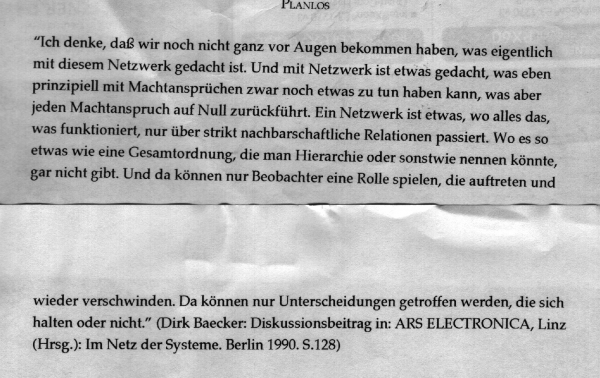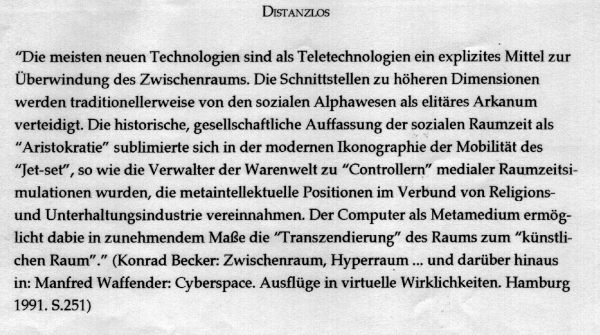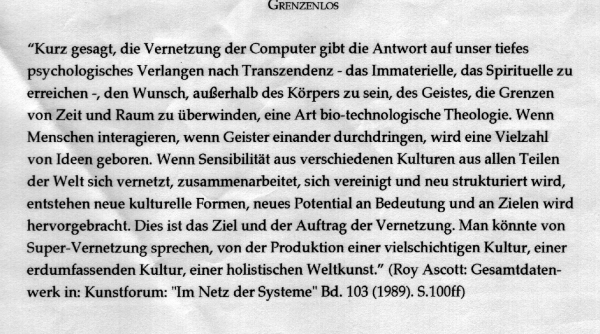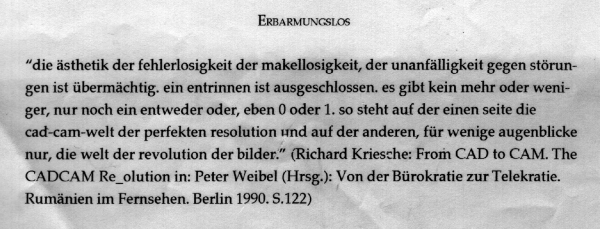Telepräsenz (PhÜD)
Inhaltsverzeichnis
- 1 Phantasien
- 2 Mediated Presence
- 2.1 The hype surrounding tele-presence deserves to be taken seriously.
- 2.2 We cannot afford current, easy explanations of tele-presence.
- 2.3 Our web of belief is under stress. Tele-presence calls for a re-examination of some basic concepts in epistemology.
- 2.4 Presence refers both to a mode of time and to a spatial quality. This link-up is under serious stress and should be used with care.
- 2.5 History is impossible without bodies, which are impossible without distance.
Phantasien
"Während also im Vietnamkrieg das zeitversetzt sendende Fernsehen ... die amerikanische öffentliche Meinung beeinflusste ..., läßt der echtzeitliche Fernsehsender aus Atlanta die gesamte Weltbevölkerung und damit die öffentliche Meinung der ganzen Welt interagieren." (Paul Virilio)
Mediated Presence
The hype surrounding tele-presence deserves to be taken seriously.
Captions like Telepresence: A Technology Transcending Time and Space or Telepresence: live, interactive, look where you want video on the Internet evoke flights of metaphysical phantasy together with more robust reflexes, familiar from e-commerce.
William J. Mitchell has noted with respect to the term cyberspace: "It's a figure of speech that has emerged to cover a gap in our language."
- Telepresence is the art of enabling social proximity despite geographical or temporal distances through the integration of computers, audio-visual, and tele-communicative technologies. [1]
Spatial distance and temporal duration seem indeed to have vanished in the age of global, inter-active telecommunication. It might be objected that networked computers have obviously neither abolished space nor time. True enough, but this objection marks a fallback position without facing the challenge.
- "geographical or temporal distance". Das Stichwort ist "Distanz". Sie tritt in zwei fundamentalen Koordinaten auf. in Raum und Zeit. Streckenmaße und Zeitmaße funktionieren jedoch verschieden. Zum Beispiel kann man sich (normalerweise) von einem Ort zu einem anderen Ort nach eigenem Gutdünken bewegen. Der Ablauf der Zeit ist nicht auf diese Weise zu beeinflussen. Der Übergang von der Vergangenheit in die Zukunft ist unverfügbar. Es gibt aber Zusammenhänge, in denen die beiden Koordinaten parallel laufen:
- eine Entfernung verkürzen
- eine Zeitspanne verkürzen
- Hier wird die Zeit nach dem Muster des Raums behandelt: Zeitspanne"", verkürzen. Umgekehrt geschieht es mit Lichtjahren, das ist eine Streckenangabe. "Die Entfernung zwischen Wien und Salzburg beträgt 2 Stunden".
- Verkürzen: Ortsbestimmungen oder Zeitpunkte werden verschoben. Oder ein kürzerer Weg bzw. ein geringerer Zeitaufwand werden eingeführt. Im Grenzfall schrumpft die örtliche Entfernung auf ein Hier und die zeitliche Erstreckung auf ein Jetzt. Es ist keine Distanz zu durchmessen und keine Zeitverlauf abzuwarten. An diesem Nullpunkt ist kein Unterschied zwischen Raum und Zeit mehr auszumachen. Wir brauchen keine Zeit um keinen Raum zu gewinnen. Das spiegelt sich in Formulierungen wie "A Technology Transcending Time and Space". "... die Grenzen von Zeit und Raum zu überwinden ..." (Roy Ascott).
We cannot afford current, easy explanations of tele-presence.
One way to see the problem is to observe that we cannot make sense of the puzzlement we are faced with, without a working distinction between proximity and distance. Paul Virilio complains that:
- "closer to what is far away than to what is just beside us, we are becoming progressively detached from ourselves." (Virilio, P. (2000). Polar Inertia. p. 83)
- Diese Beobachtung arbeitet mit einer Rochade des Distanzbegriffes zwischen Raum und Zeit.
- "weit entfernt" sowie "gerade neben uns" sind räumlich gedacht: andere Weltgegenden, direktes Umfeld
- "näher" kann nicht im selben Sinn räumlich gedacht sein, das wäre einfach ein Widerspruch
- es geht darum, dass die räumliche Entfernung durch die bildhafte Darstellung des Entfernten in der Zeit der Gegenbenheit des jeweiligen Standortes angeglichen wird
- es schrumpft die Zeit, die konventionell nötig wäre, um an den entfernten Ort zu gelangen
- Virilio spricht davon, dass in der Television die Parallelführung der räumlichen und zeitlichen Ausprägung des Distanzbegriffes nicht mehr funktioniert. Wir werden uns selber fremd, weil unserer Kompetenz, mit dem jeweiligen Umfeld zurechtzukommen, die "Einspielungen" räumlich entfernter, aber dennoch simultaner Zustände in die Quere kommt. Der Angelpunkt dieser Rochade ist die symbolische Repräsentanz räumlich entfernter Umstände in lokal ablaufenden Wahrnehmungsverläufen.
- Der komplizierte Sachverhalt wird durch eine geregelte Verwendung des Doppelsinns von "Nähe" wiedergegeben. In einem Aufzug bedeutet sie etwas anderes, als in einer Erinnerung oder Erwartung. Das ist eine schon lange eingespielte sprachliche Strategie. Hinzu kommt nun, dass sich die Zeitdimension audio-visueller Repräsentationen ändert. Es geht nicht mehr nur um Tonbandaufnahmen aus Kassette oder Photos vom Urlaub, sondern um Liveübertragungen, d.h. die Übermittlung von Information räumlich entfernter Umstände mit einem zeitlich minimalen Entfernungsfaktor.
- Das Begriffspaar "Nähe und Entfernung" funktioniert in einer ersten Annäherung wie "links und rechts", in wechselseitiger Interferenz der beiden Pole. Wenn man vor dem Spiegel steht kommt man mit links und rechts in Schwierigkeiten und muss den Gebrauch dieser Ausdrücke anpassen. Damit vergleichbar ist die Situation, in der sich nah und fern in Raum und Zeit nicht mehr koordiniert verhalten.
- Eine spezielle Schwierigkeit besteht darin, dass das Begriffsverständnis in solchen Verläufen nicht einfach verändert wird. Vielmehr sind das herkömmliche und das neue Verständnis im Spiel. Das alte links/rechts-Verständnis muss aufrechterhalten bleiben, damit verstanden werden kann, was sich im Spiegel zeigt. Entfernung in der Zeit im Sinn der Erfordernis, für die Erreichung entlegener Orte Zeit zu brauchen, muss verstanden werden, damit man mit der Entwicklung umgehen kann, dass diese Entfernung in einem anderen Sinn wegfällt.
Our web of belief is under stress. Tele-presence calls for a re-examination of some basic concepts in epistemology.
- Die sprachphilosophischen Überlegungen können durch Hinweise auf erkenntnistheoretische Verschiebungen ergänzt werden.
Human perception is regarded as an essential ingredient in the acquisition of knowledge. Humans are sentient organisms, interacting with their environment in space and time, according to their capacities of apperception. It is trivially true that sensual input into the nervous system has to be triggered by stimulation arising within the vicinity of the receiving entity. Anti-metaphysical empirical philosophy, in due course, established sensory affection as a prerequisite of the epistemological process.
Causal chains are, however, not restricted to the neighborhood. A person can be affected by nuclear radiation or by the depletion of the earth' ozone shield. The scope of technologically mediated impingement upon the human subject has been spectacularly enlarged in the preceeding century, just think of electricity, wireless communication and computer networks. Our familiar epistemological scenario has been developed to model the cognitive process accompanying the lightening of a candle, but it is seriously overtaxed in dealing with a light switch.
- Menschen stehen unter dem Einfluss zahlreicher natürlicher Prozesse. Die Frage danach, worauf sie sich rational verlassen können, ist ein anderes Thema. Ab dem Zeitpunkt, zu dem nicht "die Weisheit der Alten" oder "Gottes Wort" die Verlässlichkeit garantierte, spielen natürliche Einflüsse eine unentbehrliche Rolle in der Rekonstruktion von "Erkenntnis". Sie wird jedoch durch eine zweite Komponente ergänzt. Menschen sind "Wesen mit Sinnlichkeit und Verstand".
The characteristic ingredient in any epistemological account is the use of signs. Semiotic dimensions are orthogonal to causal dependencies. Perceiving a word or a picture is not just a case of submitting to a physical input. The recognition of an actress in a newspaper, to pick an example, is peculiarly exempt from her physical whereabouts. The workings of human cognition have usually been discussed within certain semiotic frameworks, the most prominent tools of mediation being concepts or sentences. Such bearers of information content seem to occupy a realm very different from electrical currents running though a wire. Still, in a way that's ancient history. One important presumption underlying the classical setup has become obsolete.
Old signs were pretty static: spoken words, texts, pictures. Their presence to the senses was an all or nothing affair. A meaningful utterance has to be heard by someone, sharing the speaker's location. A given text had to be perceived within a narrowly defined environment. There simply was no option of a text being presented via causal mechanisms from the opposite end of the world in real time.
A dramatic change has, however, occured on the level of technological mediation: contemporary machinery allows us to significantly enhance the causal underpinnings of sign systems. It has become impossible to base knowledge claims exclusively on neighbourhood perception. A live report on TV does not fit into the pattern of the testimony of the senses. When a reporter addresses her audience via a screen we assume a causal chain leading far beyond the living room and giving credibility to her sentences. Classical epistemology distinguishes between sensual affections and conceptual activity. It does not provide a place for cognitive content transmitted by instant tele-mediation.
Presence refers both to a mode of time and to a spatial quality. This link-up is under serious stress and should be used with care.
- Auf der einen Seite steht der Sprachgebrauch, auf der anderen Versuche, die Position von Menschen in der Welt, in welcher sie leben, sachgerecht zu bestimmen. Die beschriebene Rochade in der Verwendung des Distanzbegriffes wirkt sich auch erkenntnistheoretisch aus.
- presence:
- zeitlich: "the present time is ..."
- räumlich: "in the presence of ...
- presence:
- Präsenz:
- zeitlich: Praesens
- räumlich: Präsenzliste
- räumlich-zeitlich: Ausstrahlungskraft, Charisma
- Präsenz:
- In diesem Begriff sind die Nullstufen der zeitlichen und räumlichen Distanz eng beisammen.
Language provides a nice illustration of the preceeding claims about the tele-epistemological innocence of classical philosophy. It offers the same expression, namely presence, to designate a given moment and attendance at a given moment. To be present easily extends into at the present time. The reason is quite clear.
Given the typical scenario of knowledge acquisition prior to the advent of telecommunication sensual perception of spatial objects -- exempting objects seen through a telescope -- coincided with their actual presence. Signs have, of course, always been able "to bridge large distances". But they were simply not hooked into an extended causal framework of technologies transmitting information from a given place to distant places with practically no delay.
- Zeichen überwinden Entfernung. Ds ist ein dritter Gebrauch des Distanzbegriffes. Es geht nicht darum, Abstände auf einer Raum- oder Zeitachse einzutragen, sondern um eine kognitive Leistung. Ein Zeichen vermittelt zwischen Gebrauchs- und Verständnisweisen, z.B. die Absicht, links abzubiegen oder die Information über einen Verkehrsstau. Diese nicht-naturalistische Funktion erfüllten sie schon immer. Nun kommt hinzu, dass sie an der überkreuzten Distanzverschiebung teilhaben. Die Zeichen für ein räumlich entferntes Ereignis sind nicht nur gegenwärtig, um einen Sachverhalt mitzuteilen. (Sachverhalte sind kognitive Konstrukte.) Sie können auch an der Kontraktion der Übermittlungszeit teilnehmen, die zwischen einem fernen Ereignis und seiner lokalen Re-Präsentation liegt.
- Das Ergebnis ist bekannt: die Ereignisse bleiben räumlich entfernt, werden aber gleichzeitig mit der jeweils operativen Lokalzeit symbolisiert. Sie sind gegenwärtig, sofern ihr symbolischer Gehalt an auseinanderliegenden Raum-Zeit-Stellen verfügbar ist.
The outcome is well known: telephone, radio, TV and the Internet offer a kind of semiotic globalization, i.e. they provide regimes of symbols that are no longer governed by the constraints common to ordinary speech, writing and print.
Make no mistake: qua signs the color dots on the monitor are not at all immediate. Their pervasive presence is not a means to overcome the distance between signifier and signified. Still, we can hardly escape the strong impression of something one might call representational immediacy which is a tentative description of a specific techno-semiotic arrangement, namely the instant availability of a set of symbols around the globe at any given time. Just think of the huge TV-screens installed in some soccer stadiums. They depict the game, as seen in million homes, to the crowd attending the actual event. To talk about the disappearance of distance and duration does seem to make sense in such circumstances.
- Die Analyse von Telepräsenz muss zwischen den drei Koordinaten Raum, Zeit und Symbolwelt unterscheiden. Ihre Besonderheit kann so beschrieben werden:
- Während die räumliche Erstreckung im alten Sinn als Distanz zwischen geographischen Koordinaten verstanden wird, tendiert die zeitliche Erstreckung, die im alten Sinn parallel zur räumlichen gelaufen ist, gegen Null. Das bedeutet für zeichenvermittelte (kognitive) Prozesse, dass sie (im alten Sinn) räumlich entfernte Umstände an (im alten Sinn) verstreuten Orten zu einem Zeitpunkt ("in Echtzeit") darstellen können.
- Einfach gesagt: Ein Fußballstadium bedindet sich in einer bestimmten Stadt, das darin ausgetragene und im Fernsehen übertragene Fußballspiel ist tele-präsent. Im Stadion kann nur eine beschränkte Anzahl von Besucherinnen sitzen; die "Teilnahme am Ereignis" ist nicht derartig beschränkt.
In tele-presence people are sharing a particular moment, but they do not share a common place in a comparable meaning of the term.
History is impossible without bodies, which are impossible without distance.
The hype surrounding tele-presence deserves to be taken seriously. But how to avoid profound hype? Here are some tentative observations on a high level of abstraction, combining both descriptive content and metaphysical impact.
The nuclear bomb was the first device which made people aware of the fact that a single, local action could have instant global repercussions up to the destruction of the planet. On a more peaceful note the moon landing was a historical moment, demonstrating how, at a certain date, the entire globe could be considered one united location. The quality of temporal presence can thus be projected onto the spatial framework. Nuclear energy and broadcasting are comparatively unsophisticated examples to make this point. Mediated presence has become much denser. In 2001 private mobile phones rather than the military power of the United States provided immediate responses to an ongoing terrorist attack. Such incidences seem to suggest that we will have simultaneity plus ubiquity in the not too distant future, i.e. tele-presence in the strong sense.
This prognosis rests upon a conceptual confusion. Symbol systems are capable of literally presenting states of affairs across big distances and they can, nowadays, be linked to their sources with the speed of light. This makes for causal simultaneity which may even go both ways, including feedback to the originating source. And causally triggered events can, in the limiting case, engulf the entire space-time.
But here is the catch as far as tele-communication is concerned: symbols are different from causes. To put it in more cautious analytic terms: we are dealing with two autonomous levels of description, difficult to reconcile. Global warming is a causal process affecting the entire planet, but it does not carry any particular information.
The fact that engineers have managed to encode content into such natural phenomena should not lead us to confuse causal connections with symbolic features. Even if the symbolic medium is, in a way, omnipresent, this does not mean that we are in the presence of the things symbolized. To use a symbolism amounts to recognize a categorical distinction between the material of the signifier and its designation. This holds for pointing to an adjacent tree as well as for recognizing the face of a singer on TV. The speed of light and feedback mechanisms simply do not enter into this equation.
The conclusion is not that one should be insensitive towards the implications of instant global signification technology. It's just a reminder that symbols differ from simple objects. Human evolution is built upon this mild case of schizophrenia which makes us able to present an object that is physically absent. Tele-presence seems to hold the promise of this gap to be eventually closed. But think again. What would be achieved if signs were to be fused with designations within a single cosmic instant?
Cosmological theory tells us that the history of the universe can only be reconstructed from radiation caught by our observation instruments in earth-time. To arrive at an astronomical understanding such signals have to be mapped back onto space-time, reintroducing distance, absence and process. Now imagine the planet viewed in God-like immediacy from a far away galaxy. All significant spatial relationships would be merged into a tiny spot of light. An intelligent being out there would have to unravel the mystery, re-introducing a pattern of spatial coordinates and symbolic communications bridging its extension to understand the human condition. The thought experiment can have a sobering effect. If you are tempted to regard tele-presence as an overcoming of distance and duration, think of yourself as looked upon from a distant galaxy. You are an unremarkable blob, waiting to be reverse engineered into a story within time and space.



